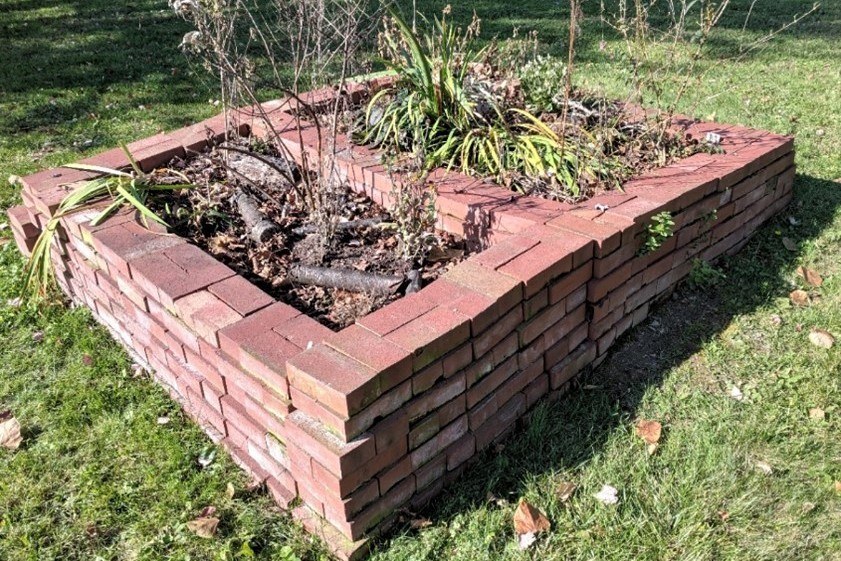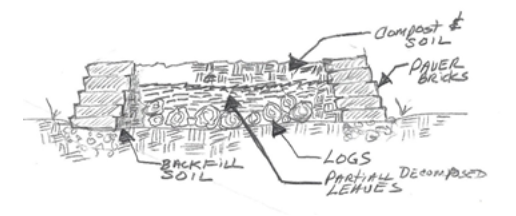Posted: January 24, 2022
Read about one Master Gardener's successful raised bed project - this may work for you!

The Brick Garden Photo Courtesy Val Inman
The rainy windy storm took down a tree in the backyard. The remaining stump and heaved ground were hard to keep weeded and neat. The stump and roots were too big to pull out.
Several trains of thought were colliding in my mind: How to beautify the stump, a friend's favorite quote, a webinar "Natures Best Hope," articles on Hugelkultur and what to do with those bricks.
- Johnnie Lightning, a grade school friend living in Hawaii has always said; "Learn to use what you have got, and you will not need what you have not."
- The webinar "Natures Best Hope," presented by Dr. Doug Tallamy, University of Delaware, discussing modern landscapes and how to provide for birds and pollinators was so thought provoking as was his article "Gardening for Life." His idea is if each of us planted a small section of ground with native plants, our combined effort would equal more than all the National Parks combined.
- The wonderful diagrams of Hugelkultur as discussed in Emily Larkins Thesis for The Stuckeman School of Architecture and Landscape Architecture, Urban Strategies for Low-Cost, Low-Maintenance Foodscaping inspired me to try it.

- The Sepp Holzer permaculture diagram and Hugelkultur article was so inspiring. Hugelkultur in German means "mound hill or hill culture." Using tough woody material at the base of a planting bed gives extra moisture, improves soil fertility, and adds warmth to the area from the decomposition process.
- And what to do with those Paver bricks? Hundreds of them were stacked against a retaining wall after removal from our repaved driveway. Not really in the way, but not attractive.
My goal was to hide that tree stump and create a raised bed for pollinator plants. There was plenty of time during the Covid lockdown of 2020 to work in the yard.
Hmm, "Use what you have got…"
The plan took shape, use the bricks as the walls for the raised bed. Using mortar was outside my expertise so dry-stacking was the method. Using double-wythe bricklaying (two long wise then one short wise, alternating for the next course) and slight inward tapering, the walls took shape. My wonderful husband helped with the moving of several wheelbarrows full of bricks, at 5 pounds per brick that really helped a lot on our hilly property. I used almost 700 bricks!
The log pile in our yard is filled with wood from other storm damaged trees and broken limbs. This pile provided my base logs for the Hugelkultur method, plus the unsightly tree stump I was hiding filled in a lot of the area within the brick walls.
Next came the organic materials layer, some from the compost bin and also partially decomposed bags of leaves saved from the previous fall. Some purchased soil was added on top of the organic materials, with some small logs on top for interest.
Irises (divided from plants in the yard), forsythia, mint, coneflower, pinks, and zinnias were planted that first summer. Native pollinator plants were hard to find that summer.
The next summer an additional section of brick walls were added in a U-shape abutting the original and in went more logs, more leaves, compost, and dirt. Native swamp milkweed, butterfly weed, cone flowers, cosmos, and more irises were planted. Thank goodness I have used all those bricks. Well, almost all, there are a dozen or so still at the retaining wall.
We are all enjoying the improved look of the brick garden. Lots of mushrooms in between the flowers. I have read that mushrooms are the reproductive structures of fungi and may indicate healthy soil for trees and other plants to grow in. The Hugelkultur seems to be working. The monarch butterflies and bees abound. The chipmunks run in and out. My neighbor said she saw our neighborhood fawn "twins" playing in and sitting on top of the brick flower bed. The deer keep the forsythia pruned nicely too.
So go ahead, learn to use what you have got and make a positive change.
Valerie Inman, Lycoming County Master Gardener

